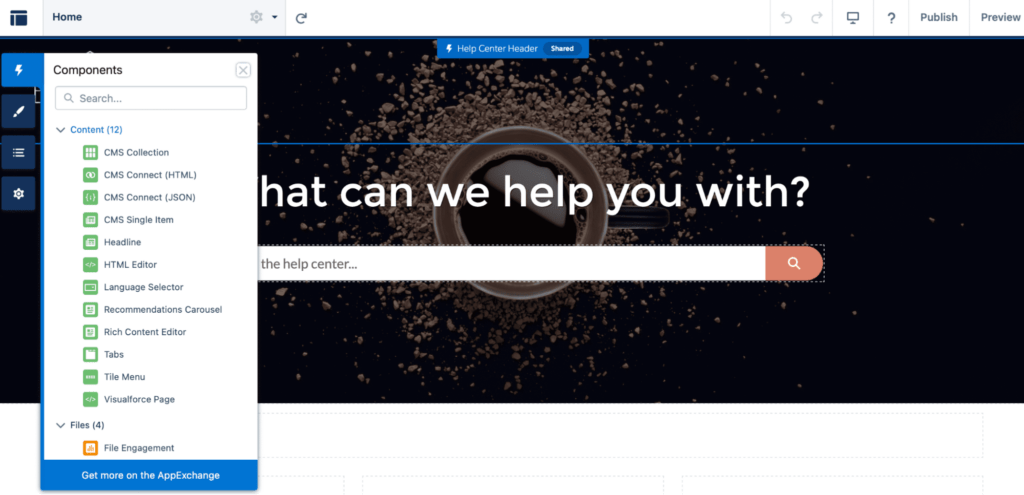
If you’re about to run the digitalization path with Salesforce and are ready to get started with the Experience Cloud platform, then this article is a must-read. We’ll show you how to create beautifully branded digital experiences that connect to your CRM without writing code and give you a list of valuable tips on launching and managing a Salesforce Experience Cloud site.
Before diving into the setup details, let’s start with the Experience Cloud site definition first.
What is an Experience Cloud Website?
You can create multiple sites and connected CRM-powered digital experiences within your Salesforce org to address different purposes and achieve multiple online objectives. It’s all possible with Experience Cloud: a software system with an integrated set of technologies, digital marketing products, services, and solutions.
Experience Cloud is a digital experience platform (DXP) that combines various capabilities (such as eCommerce, content management, personalization, marketing, analytics, and customer care) to deliver consistent omnichannel digital experiences from a single software.
All data from your site live in your Salesforce org. It can be easily and safely shared externally and delivered to customers. In this way, Experience Cloud serves as a window into your Salesforce org.
Let’s dig deeper and see why you’d want to create websites using Salesforce Experience Cloud.
Why Use Salesforce Experience Cloud for Creating a Site?
Salesforce Experience Cloud sites help you create and manage all of your digital content and assets to easily conduct your business online and keep your organization running smoothly and securely.
Building sites using Salesforce Experience Cloud is an excellent choice if you’re looking for a flexible, easily configurable, and no-code solution.
Salesforce Experience Cloud sites help you:
- Accelerate channel sales
- Deliver self-service
- Integrate eCommerce
- Engage with customers and empower partners
- Digitize business operations
- Gather actionable customer insights
- Measure partner performance
- Boost brand engagement
By starting your digital transformation with Salesforce Experience Cloud, you’ll enhance your company’s processes and deliver better customer experiences, ensuring the growth of your business.
5 Beginner Tips for Launching Your First Salesforce Website
With Salesforce Experience Cloud, you can build and set up various digital experiences to match your particular needs. Whether you’re about to launch a partner portal, a help forum, a support site, a microsite, or a customer community, you should read about best practices and explore the intricacies of a Salesforce Experience Cloud integration.
Here’s our experts’ collection of tips and tricks that will make creating and modifying your Experience Cloud site a breeze:
- Trailhead courses. Trailhead is a learning platform that provides a training environment and a series of free gamified online tutorials for anyone who wants to learn Salesforce. With Trailhead courses, you’ll get the digital and soft skills you need to successfully launch your first website.
- Use community groups. Never hesitate to ask for advice or help. In community groups, you can communicate directly with the product team and with other Salesforce enthusiasts to keep on top of product and service news.
- Start with templates. Salesforce provides you with a bunch of ready-to-use, fully-customizable templates so you can build your first site easily and fast while still meeting your needs.
- AppExchange integrations. In order to enhance your community functionality, enrich the customer experience, and maximize the value of your website, consider integrating third-party components and applications found on AppExchange.
- Use Lightning Bolt solutions—a combination of components, apps, processes, and templates designed to work together—to help you customize and deploy your community fast with clicks, not code. Lightning Bolt solutions are built with Salesforce partners and integrated with Customer 360.
Setting Up a Salesforce Experience Cloud Website: Step-by-Step Instructions
Now you know what an Experience Cloud site is and the value it brings. What’s next? Creating and setting up a Salesforce website from scratch may be challenging for beginners, but we’re here to help! Here’s how to set up an Experience Cloud site step-by-step.
How to create an Experience Cloud site:
1. Enable Digital Experiences in your org. From Setup, enter “Digital Experiences” in the Quick Find box, select Settings, and select “Enable Digital Experiences.”

2. Select a domain name and click “Check Availability” to make sure it’s not already in use. Click the “Save” button.

3. Create an Experience Cloud site. You should have been redirected to the All Sites page. In case you haven’t, enter “Digital Experiences” in Quick Find and select All Sites. Click “New” to create a new Experience Cloud site.

4. Pick an out-of-the-box customizable template and get started. Each template is prebuilt with page layouts and components tailored for specific use cases. Choose the one that best fits your needs, for example, Customer Account Portal, Help Center, Partner Central, B2C Commerce, etc.).

5. Name your site and enter the URL. The system automatically brings you to the My Workspaces page, where you will customize and administer your site based on your needs and preferences.

6. Choose “Builder” to start the customization of your site’s pages. Apply a theme to beautify your site. Salesforce provides you with a library of prebuilt themes to create an incredible experience for your users with just a couple of clicks. You can also customize your site by changing the colors, fonts, and styles, uploading logos and images, and playing with page structure and content.

7. Drag and drop powerful CRM components on your website pages. In the upper left-hand corner, choose the “Components” tab to start installing apps and components according to your needs.

8. If you need to go back to Setup, click “Workspaces” on the upper left corner of the page, and choose “Salesforce Setup.”

Salesforce Experience Cloud Site Management: Key Things to Know
Monitoring and managing your Experience Cloud site is key to its success. This part of our article will give you the best advice and tips on how to achieve that success.
Your task as a community manager is to make sure that…
- …your site is active, and members are logging in regularly
- …site members are engaged and motivated to participate on a regular basis
- …your site is up-to-date and provides only appropriate and relevant information.
Whether you’re managing a Salesforce PRM, a help center, or an eCommerce site, remember the following:
- After launch, you need to assign an Experience Cloud Site Manager by giving them “Manage Experiences” permission. Don’t forget to assign a moderator so they can keep an eye on your site’s content (i.e., feeds, files, chatter messages).
- Start with the “Salesforce Experience Management Package with Chatter.” The Experience Management package delivers the insights, dashboards, reports, and moderation controls community managers need to drive adoption, monitor engagement, and build a vibrant community.
- Create and modify rules for your Experience Cloud site to moderate member-generated content. Moderation rules help protect your site from spammers, bots, and offensive or inappropriate content.
- Allow members to flag posts, comments, files, and inappropriate or spam messages. This improves the quality of your site content.
- Consider using Transaction Security to enhance the protection of your site data. It’s a feature that monitors Salesforce events (clicks, record state changes, etc.) in real-time to spot potential trouble based on the rules you create.
- Navigational, featured, and content topics are a great way to organize information and content on your site. Using topics, you can highlight current, popular conversations, boost engagement, and much more. As the number of topics in an Experience Cloud site grows, it’s important to curate them to improve usability.
- Create recommendations encouraging users to watch videos, take pieces of training, and more. Define specific audiences and use channels to specify locations for the recommendations.
- Use gamification tools, like Recognition Badges and Reputation, to keep your members engaged with your site.
- When letting guest users upload files, don’t forget to restrict the size and types of files they can upload. This will help you control what your users upload and prevent spammers from polluting your site with improper files.
Final Thoughts
Salesforce is widely used in a variety of industries, including healthcare, financial services, consumer goods, government, education, philanthropy, donations (Salesforce for nonprofits), etc. No matter what industry your organization belongs to, Salesforce is always a great choice for starting your digital transformation.
If you’ve decided to switch to Salesforce but still need help, let us know! We’ll provide you with a Salesforce-certified Experience Cloud consultant to help you implement and configure your community.
Working across multiple industries, we at Advanced Communities have a wealth of experience creating, configuring, and developing feature-rich and engaging Salesforce experiences. Contact us for more information or professional assistance.








